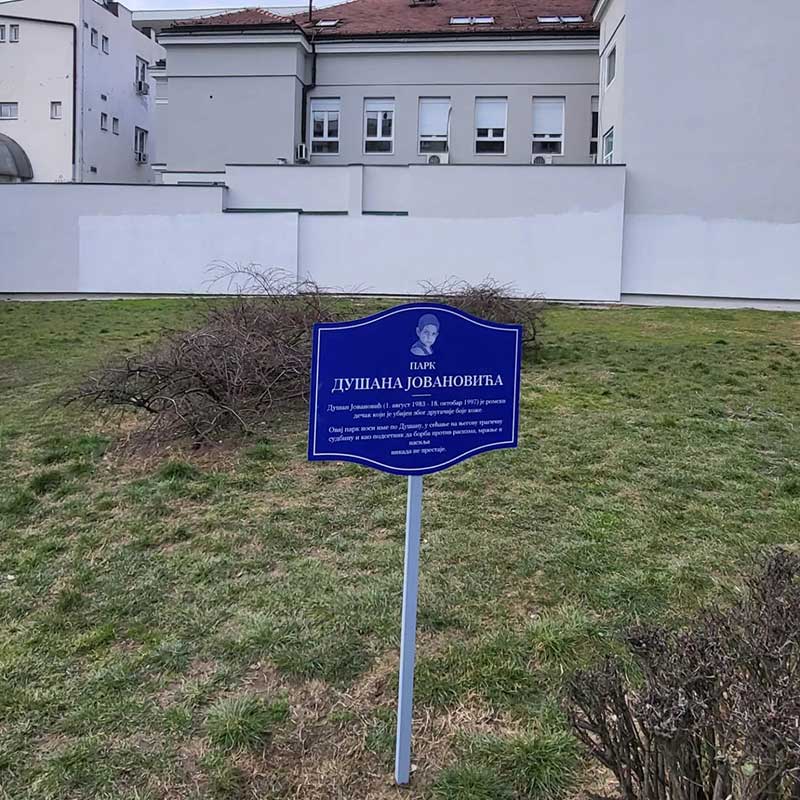
22 May THE DAY WE FELL INTO THE MITIĆ HOLE
Below, you can read an original text titled The Day We Fell into the Mitić Hole or The Park for Children who Cannot Read, which was prepared for Peščanik by our lawyer Miloš Janković. Since February 18, when together with the Youth Initiative for Human Rights we organized a legal civic gathering and cleaning of the park, until today, people and activists who participated in the action have received a total of over 30 misdemeanour charges, even though the gathering was carried out with the approval and protection of the police. The hearings of participants and activists are well underway, and we cannot help but notice that this is an organized and tactically planned silencing of people who attempt to influence dangerous local policies and legally advocate changes with the people/decision makers they have chosen because they want our children to live in a healthier society, where messages of hatred, war and aggression are not imposed violently and unilaterally, but where walls are legally decorated with messages of empathy, humanity and love. SLAPP prosecutions have become a daily occurrence for all of us who do not want to remain silent about things we think are dangerous and unacceptable. Please share this message, support us and follow the course of all the lawsuits, because we enter them for the sake of everyone and for our common future.
THE PARK FOR CHILDREN WHO CANNOT READ
The events of February 18, 2023 in the park at the so-called Mitić hole at Slavija Square in Belgrade have been falsely portrayed in public and in the proceedings initiated before the responsible authorities.
A gathering was organized to clean the park and children’s playground, and to remove the mural from the wall of the Institute of Chemistry, Technology and Metallurgy, which borders the western side of the park. The reason for removing the mural is that its dominant message was inappropriate for children, as it refers to the military engagement of the Serbian army in Kosovo.
Residents of the area who bring their children to the park expressed the wish to clean it of rubbish and the mural with a message that is inappropriate for children. The event was supported by civil activists, whose idea was that children should be protected from politics, incitement to war and the promotion of any kind of violence.
This public gathering was announced to the Ministry of Internal Affairs in good time. The announcement clearly stated that the actions of cleaning the park and removing the mural with inappropriate content from the building of the Institute of Chemistry, Technology and Metallurgy would be carried out, and that the goal of the gathering was to restore a public area primarily intended for children to its original condition. The responsible authority did not issue a decision to forbid the gathering. Otherwise, it would have been prohibited.
During the event, some of the participants collected the scattered rubbish, while another group started repainting the controversial text of the mural with white paint, the same shade as the colour of the wall of the renovated building.
Immediately after the gathering began, the municipal police intervened among the public, demanding that the painting of the wall be stopped. Some of the policemen tried to force the people to stop their attempt to clean the wall of the inappropriate mural. After the gathering, they filed a large number of misdemeanour charges, in which they claimed that they had found people using a roller to apply white paint to the wall of the building, thereby damaging its external appearance.
If the opinion of the municipal police were to be accepted, that by painting the wall white, the external appearance of the building was being damaged (even though it was originally white), then the exterior appearance of the building must also have been damaged by the previously painted mural. It could be concluded that by placing the mural which the people were repainting white under protection, the municipal police were effectively protecting from damage a previously damaged appearance of the building.
If the gathered people had not started painting the wall in its original white colour, but had written different political or social messages over the existing mural, the filing of misdemeanour charges would not have been in dispute. However, in this case, the obvious protection of a mural whose dominant content is war-mongering, displays a political position expressed by the municipal police on the necessity of military engagement of the Serbian army in Kosovo, that is, that the issue of Kosovo should be resolved by military means, which is unacceptable.
In support of the tendentious behaviour of the municipal police, the fact that they were particularly zealous in filing misdemeanour charges against people who painted the wall in its original white colour, while they were (and are) failing to file charges against those who in the same place had previously written, and immediately after repainting the wall in white again wrote, several texts with inappropriate content.
It is interesting that when new texts were written on the same wall, among other things there appeared “Vučić is a gay” and the Latin letter Z, which were soon painted over. In relation to that repainting, no charges were filed. When asked why the other messages and symbols had not been deleted, the sarcastic answer was: “the paint ran out”.
In the event described here, the residents made a clear contribution to the cleaning of park and playground for children. The wall bordering the western side of the park remained undamaged for a short time after being painted. Now there are again inappropriate messages for children on it. In the meantime, the people who tried to take an initiative and make the park, the playground and its surroundings suitable for children are receiving summonses from the Magistrates Court, before which they will have to prove that they did not damage the external appearance of the building, but that they tried to restore it to its original condition precisely because it was disfigured by inappropriate graffiti.
While we await the magistrates’ decisions, children will continue to play in the park. Given the possibility that a child will read the text with inappropriate content written on a nearby wall, perhaps some upstanding citizen will place a sign at the entrance to the park with the inscription: ONLY FOR CHILDREN WHO CANNOT READ.
Author: Miloš R. Janković
Source: pescanik.net



Sorry, the comment form is closed at this time.